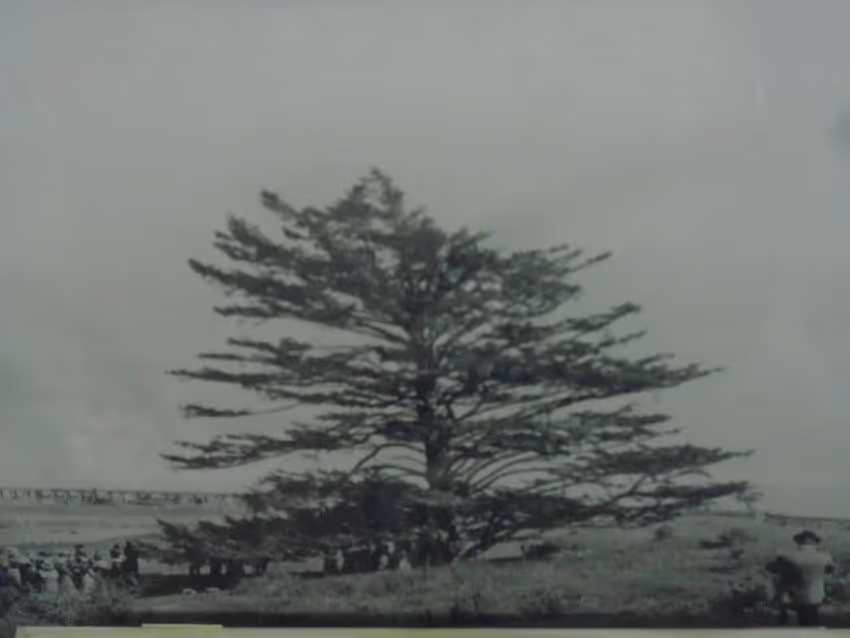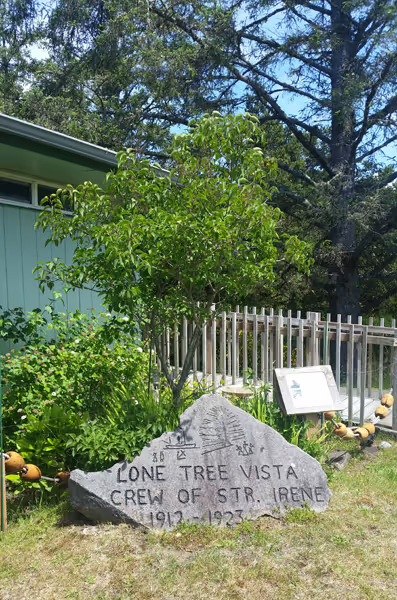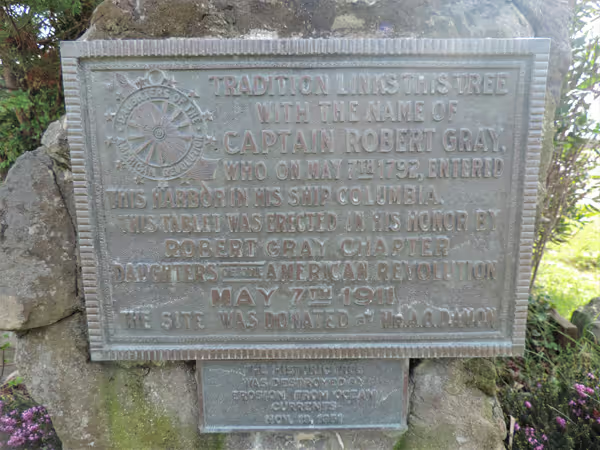The Lone Tree



Native Plant Appreciation Month begins on Friday and this year's theme is "Exploring the Future of Washington's Trees." To celebrate, we're going to take a look at the most famous tree in Ocean Shores: the Lone Tree.
The Lone Tree, also historically referred to as the Beacon Tree, was a spruce that once stood on the edge of the peninsula in the area now known as Damon Point. The location of the tree made it easy to spot from the Pacific Ocean and thus an ideal guide for mariners looking to enter the harbor. Captain Robert Gray is thought to have used the Lone Tree to guide his ship, the Columbia Rediviva, into what would later be called Grays Harbor on May 7th, 1792.
While Captain Gray's use of the Lone Tree has yet to be definitively proven, there is no doubt that many mariners have used the Lone Tree as a guide when entering the harbor throughout the 19th and early 20th centuries. One of these mariners was Agnes "Aggie" Taylor. She and her father would use the Lone Tree as a guide while in their steamer Irene. (Woodwick 2010)

There was even a small village on the point from 1904-1916 named after the Lone Tree (Meany 1920; Lone Tree History 2019). Built to fulfill the needs of the North Jetty construction workers, the village had a "post office, stores, homes, boardinghouses, rail system, and a huge swamp works" (Woodwick 2010).
On October 21st, 1935 the tree was felled in a storm. While its exact age at the time is unknown is was considered to be quite old (Meany et al 1935).
On May 7th, 1911 the Robert Gray Chapter of the Daughters of the American Revolution erected a bronze plaque on a 10-ton block of granite near the Lone Tree (Thirteenth Report 1911). The plaque was recovered after the storm, remounted, and moved to two different locations, first at the junction of SR 109 and SR 115 and later near the Ocean Shores Community Club (Woodwick 2010). In the summer of 2017, the plaque was restored and relocated to the Coastal Interpretive Center where it is currently located in our outdoor exhibits. The rededication ceremony took place on May 7th, 2018 (DAR 2020, Daily World 2018).

The legacy of the Lone Tree can be felt throughout the city of Ocean Shores and beyond. In addition to the plaque, there are street names and businesses named after the Lone Tree and it has inspired numerous works of art. What's more, the wood of the tree was used to make several artifacts. For instance, the Museum of History and Industry in Seattle has a gavel (2009.94.2) and a miniature lighthouse (1955.970.192) made with wood from the Lone Tree in their collection.
However, photographs, memories, artworks, and commemorative plaques are not all that remains of the Lone Tree. After the storm, Mrs. H. W. Patton recovered broken limbs from the tree and sent them to the University of Washington (Meany et al 1935). Seedlings were created from the remains of the tree and a descendant now stands along the front pathway of the Lord Mansion in Olympia (Sanchez 2020). The descendant tree received its own historic marker on February 28th, 1961, placed to honor Charles Tallmadge Conover who nicknamed Washington "The Evergreen State" (Stevenson 2001). Thanks to Mrs. Patton and the University's work, we may enjoy descendants of the Lone Tree for some time to come.
References
Daughters of the American Revolution Robert Gray Chapter. (2020). Retrieved March 22, 2022, from http://sites.rootsweb.com/~wargcdar/
“Gavel made from wood of the Captain Robert Gray "Lonetree" at Grays Harbor, Washington, ca. 1934.” 2009.94.2. MOHAI.
“Lone Tree” 1998.01.01. Coastal Interpretive Center.
Lone Tree history, Ocean Shores, Washington. (2019). photograph, Moclips. Retrieved March 24, 2022, from https://www.washingtonruralheritage.org/digital/collection/oceanshores/id/414/.
Meany, E. S. (1920).“Origin of Washington Geographical Names.” The Washington Historical Quarterly, 20(2), 120.
Meany, E. S., Bonney, W. P., Elliott, T. C., Shiels, A. W., McMahon, E., Kingston, C. S., Sperlin, & O. B., Howay, F. W. (Eds.). (1935). The "Lone Tree" Destroyed. The Washington Historical Quarterly, 26(1), 74.
“Miniature lighthouse with wood from the Lone Tree in Gray's Harbor, 1921.” 1955.970.192. MOHAI.
Robert Gray Dar chapter will dedicate restored Lone Tree Marker. The Daily World. (2018, May 2). Retrieved March 23, 2022, from https://www.thedailyworld.com/news/robert-gray-dar-chapter-will-dedicate-restored-lone-tree-marker/
Sanchez, R. (2020, August 24). Take a walk and learn about Olympia's famous trees. ThurstonTalk. Retrieved March 23, 2022, from https://www.thurstontalk.com/2020/08/22/talk-a-walk-and-learn-about-olympias-famous-trees/
Stevenson, S. (2001, July). Stevenson: Thurston county markers. Olympia Historical Society and Bigelow House Museum. Retrieved March 24, 2022, from https://olympiahistory.org/stevenson-thurston-county-markers/
Thirteenth Report of the National Society of the Daughters of the American Revolution (1911). (doc) (pp. 146–147).
Woodwick, Gene (2010). Ocean Shores. Arcadia Publishing.
© Laura Caldwell, March 2022
Touch whale bones, examine shipwreck artifacts and connect with the coast's living history.

Support our mission, get involved in educational programs, or contribute through donations and volunteering.